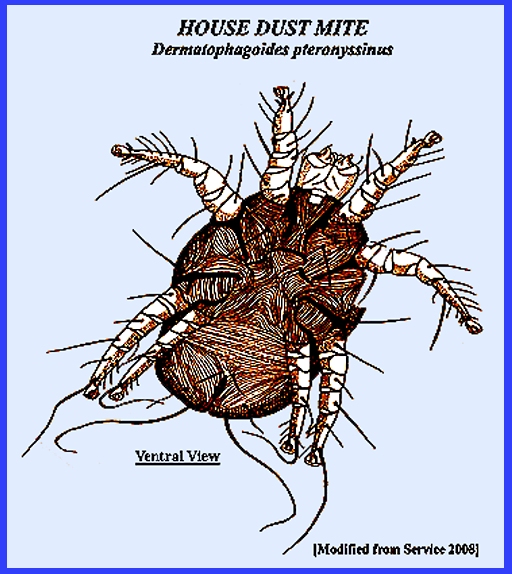File: <housedustmite.htm> <Medical
Index> <General Index> Site Description Glossary <Navigate
to Home>
|
HOUSE DUST MITES & Other Mites Acarina: Pyroglyphidae, Dermanyssidae,
Mesostigmata, Pyemotidae (Contact) Please
CLICK on
image & underlined links for details: HOUSE DUST MITES Dust mites are very tiny and can be found in carpets,
mattresses, clothes and other dusty areas.
Female mites oviposit up to 3 eggs daily, and these hatch about 6-13
days later with a larva that has six legs.
The larva passes through two nymphal stages before adulthood, with the
complete cycle taking around three or four weeks. Service (2008) emphasized that the most important breeding
sites are in beds. The mites rely on
fungi that occur on the floors and mattresses and other organic debris, where
they require high humidity for survival.
Adult mites can live up to two months during which they may lay 80
eggs. Because of their small size
they are not easily viewed and they can be spread locally when bedding is
shaken into the air. Inhalation of
the mites and their feces causes allergic symptoms that can lead to asthma,
eczema and rhinitis. OTHER MITE SPECIES Many other mites attack birds, mammals, livestock, insects
and humans. The grain mite, Pyemotes
tritici that parasitizes beetles and moths, also attacks
humans that are working nearby. The
chicken mite, Dermanyssus gallinae,
rat mite, Ornithonyssus bacoti,
and tropical fowl mite, O. bursa also sometimes
attack humans. Service reported that
bites from these species may cause dermatitis and irritation. Other mites that infest rodents, such as Liponyssoides
sanguineus, transmit Rickettsial pox (Rickettsia akari) and with mites can
also vector Q Fever (Coxiella burnetii)
to humans. Service (2008) lists other
mites occurring in food products frequently cause allergies and dermatitis as
well as bronchitis and asthma in people who accidentally encounter them. CONTROL Control is difficult or almost impossible for some
infestations. Mite population
densities can soar to five-hundred or more individuals per one gram of
dust. Mites cannot be removed from
carpets with a vacuum because of their firm clinging capacity. Washing clothing and bedding in hot water
or dry cleaning kills mites, but the applications of miticides to
mite-inhabited areas have been used with only limited success. The use of allergy medications may provide
some relief from respiratory problems associated with exposure to the mites. = = = = = = = = = = = = = = = = = =
= = Key References: <medvet.ref.htm> <Hexapoda> |
|
Akilov, O. E. & K.
Y. Mumcuoglu. 2004. Immune response in demodicosis. J. Europ. Acad. Dermatology &
Venereology 18: 440-444 Boner, A., L
Pescollderungg & M. Silverman. 2002. The role of house dust mite elimination in
the management of childhood asthma:
an unresolved issue. Allergy 57 (Suppl 74), pp. 23-31. Cameron, M. M. 1997. Can
house dust mite-triggered atoic dermatitis be alleviated using
acaricides? Brit. J. Dermatol.
137: 1-8. Cloosterman, S. G. M.
& O. C. P. van Schayck.
1999. Control of house dust
mite in managing asthma: effectiveness of measures depends on stage of Asthma. Brit. Med. J. 381, p. 870. Colloff, M. J., J.
Ayres, & F. Carswell 1992. The control of allergens of dust mites
& domestic pets: a position paper.
Clinical & Expt. Allergy 22:
1-28. Fain, A., B. Guerin
& B. J. Hart. 1990. Mites and Allergic Disease. Varennes en Argonne, Allerbio, France. Harvey, P. & R.
May. 1990. Matrimony, mattresses and mites. New Scientist 3: (March): 48-49. Herron, M. D., M. A.
O'Reilly & S. L. V. Ganderhooft.
2005. Refractory Demodex folliculitis in five children
with acute lymphoblastic leukemia Pediatric Dermatology 22: 407-411. Krantz, G. W. 1978.
A Manual of Acarology, 2nd ed., Oregon St. Univ., Corvallis. Lovik, M., P. I.
Gaarder & R. Mehl (eds.). 1998. The house-dust mite: its biology and role
in allergy. Proc. Internat. Scien.
Workshop, Oslo, Norway, 4-7 Sept. 1997. Allergy 53 (Suppl. 48): 1-135. Matheson, R. 1950. Medical Entomology. Comstock Publ. Co, Inc. 610 p. McDaniel, B. 1979. How to Know the Mites and Ticks. W. C. Brown Publ, Dubuke, Iowa. Mumcuoglu, Y. 1976.
House dust mites in Switzerland: I.
Distribution and taxonomy.
J. Med. Ent. 13: 361-373. Owen, S., M.
Morganstern, J. Hepworth & A. Woodcock.
1990. Control of house dust
mite antigen in bedding. Lancet 335: 396-397. Rosen, S., I. Yeruham
& Y. Braverman. 2002. Dermatitis in humans associated with the
mites Pyemotes tritici, Dermanyssus gallinae, Ornithonyssus bacoti
and Androlaelaps casalis in
Israel. Med. & Vet Ent. 16: 442-444. Service, M. 2008.
Medical Entomology For Students.
Cambridge Univ. Press. 289 p Siebers, R., H. S. Nam
& J. Crane. 2004. Permeability of synthetic and feather
pillows to live house dust mites and house dust. Clinical & Expt. Allergy 34: 888-890. Walter, D. E. & M.
Shaw. 2005. Mites and disease.
IN: Biology of Disease Vectors,
2nd edn. Elsevier Acad. Press. pp. 25-44. Wharton, G. W. 1976.
House dust mites. J. Med. Ent.
577-621. |
